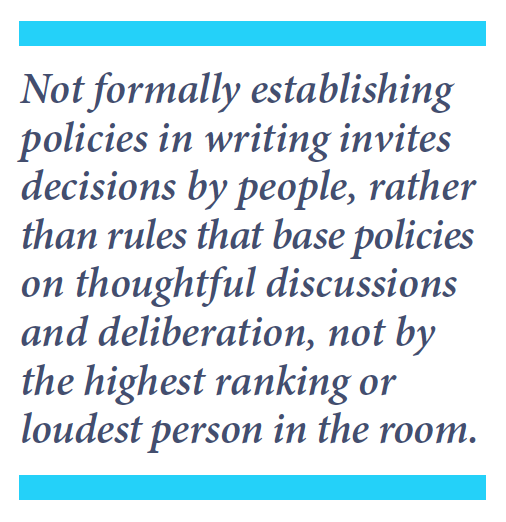When speaking about club governance, we distinguish between principles and practices. Principles are those elements of a governance model that are to be held inviolate. The five principles that are critical to the efficiency and effectiveness of a club governance model are:
- Clarity of authority transfer
- Clarity of accountability
- Board speaks with one voice – in writing
- Selection of board members on the merits
- Committing to excellence
In previous articles in this issue, we addressed principle three in our discussion of a board policies manual and principle four in our dream team feature. Now we will cover the remaining principles.

Clarifying and Trancing Authority and Accountability
Both member policies (bylaws) and board policies (board policies manual) play a key role in transferring authority and assigning accountability. The bylaws not only describe the governing body (board), including its size, officers and terms of service, but also the authority the members delegate to the board. Some bylaws give broad, wide ranging authority without detail, while other bylaws list specific duties the board is authorized to carry out. Almost all bylaws contain caveats that limit the board’s authority, such as a limitation on assessments, selling property or amending the bylaws. While a small minority of club bylaws will permit the board to amend the bylaws, the vast majority require amendments to be approved by the members.
Although all clubs have bylaws that convey authority from the members to the board, in too many clubs, the authority transfer gets stalled at the board level. In order to honor the first basic principle, the board must clarify in writing how it will use its authority to achieve the club’s mission. A board policies manual (BPM) is the most efficient and effective method for the board to communicate how it will use the authority given it in the bylaws. Just as the bylaws delegate authority to the board with certain caveats, so the board delegates authority in a BPM to the general manager with caveats and the general manager to his/her staff with caveats in staff handbooks. Each level of the organization therefore understands what decisions it is permitted to make. If the boundaries for decision-making shift because of a changing situation, the appropriate document conveying the authority is amended.
Accountability Through a BPM
In the same way a BPM makes clear how the board will be structured, how it will operate and what authority it will grant the general manager, it also makes clear how the board will hold the general manager accountable for exercising the authority to accomplish the club’s mission. The BPM includes a list of reports it expects to receive from the general manager along with their frequency. It also includes a reference to the strategic plan and how the decisions by the general manager are expected to align with the plan. Finally, a BPM includes the annual goals or benchmarks on which the general manager will be evaluated. Just as important as clearly documenting the transfer of authority is clearly articulating accountability, such as clarifying what is expected of the general manager in utilizing his/her delegated authority. In this case, documenting means explicit written policies. Too often boards operate on implicit policies, relying on word of mouth, tradition, experience of officers or some other source for making decisions. Not formally establishing policies in writing invites decisions by people, rather than rules that base policies on thoughtful discussions and deliberation, not by the highest ranking or loudest person in the room.
One of the most frequent messages we hear during member focus groups is the perceived lack of transparency on the part of the board. Such a perception often leads to distrust and unwarranted criticism. Explicit policies appropriately cataloged in a BPM will not only provide for a clear description of authority and accountability, but it will also communicate a posture of transparency between the board and the staff as well as the board and the membership. A board that makes clear in a BPM how it will employ its authority displays both an openness to the members as well as its accountability to them.
Committing to Excellence
The fifth principle of good club governance is a commitment to excellence. In a way, this is a catch-all principle that subsumes best practices, i.e., policies and methods that foster efficiency in governing, effectiveness in operations and cohesiveness in the community. It’s the principle of encouraging boards to initially look for ways to get good and constantly seek ways to stay good. Strategic plans almost always need to be reviewed and refined as assumptions or trends change. Board policies will require additions, deletions or amendments. Operations rules and regulations also must adjust to the times. But responding to change must be orderly and not responsive to a whim. Good boards document their plans but are ready to alter them after due consideration of the reasons for change. In the same way good boards develop and publish board policies, it should use them as a governance management system, and adjust them as situations warrant. Sustaining good governance is neither about rigidly holding on to current policies nor about making hasty changes in course.


